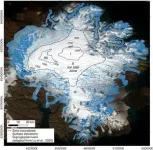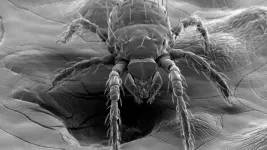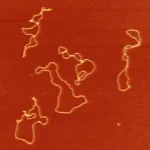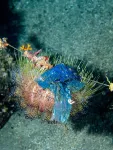(Press-News.org) Scientists at the University of Texas Institute for Geophysics (UTIG) have developed a radar technique that lets them image hidden features within the upper few feet of ice sheets. The researchers behind the technique said that it can be used to investigate melting glaciers on Earth as well as detect potentially habitable environments on Jupiter’s moon Europa.
The near-surface layers of ice sheets are difficult to study with airborne or satellite ice-penetrating radar because much of what’s scientifically important happens too close to the surface to be accurately imaged. That has left scientists relying on ground instruments that give only limited coverage, or extracting ice cores — a difficult and time-consuming operation currently impossible to do on other planets.
The new radar technique combines two different radar bandwidths and looks for discrepancies as a way of boosting the resolution. Because the instruments are carried on airplanes or satellites, scientists can quickly survey vast regions of ice.
To test the new technique, the team flew radar surveys over the Devon Ice Cap in the Canadian Arctic where they mapped a slab-like layer of impermeable ice near the surface. Further analysis suggested that the ice layer is redirecting surface melt from the ice cap’s snow-packed surface into water channels downhill. The research was published May, 2023, in the journal The Cryosphere.
According to Kristian Chan, a graduate student at the UT Jackson School of Geosciences who devised the technique, the study’s findings about the ice slab layer could help scientists predict the future of the ice cap and its contribution to sea level rise.
“If you have only relatively thin ice layers then the firn [snow-packed surface layers] has the ability to absorb and retain surface meltwater,” Chan said. “But if these impermeable slabs are widespread then the contribution of surface melt to sea level rise is enhanced.”
Surface melt is normal on ice sheets during summer months. As the top of the previous winter’s snow warms up, meltwater sinks in and refreezes deeper in the snow, forming thin ice layers.
Most of the ice layers on Devon Ice Cap, however, are much thicker than expected, some forming slabs as much as 16 feet thick over several miles. That makes them very effective at redirecting meltwater, which the researchers confirmed when they matched the location of the thickest ice slabs with that of meltwater rivers.
Chan said the findings demonstrate what scientists can accomplish with the new technique.
“We used an airborne radar to find ice slabs on Devon Ice Cap, but the same thing applies for detecting layers with an orbiting radar at ice-covered ‘ocean’ worlds like Jupiter’s moon Europa,” he said.
Chan is part of a UTIG group, led by Senior Research Scientist Don Blankenship, that is developing a radar instrument called REASON, which will launch aboard NASA’s Europa Clipper in 2024. Along with a European Space Agency spacecraft that launched this year, scientists will soon have two ice-penetrating radar instruments investigating Jupiter’s moons Europa and Ganymede. Both radar systems are compatible with Chan’s technique.
With the new technique, scientists will be able to peer into the upper few feet of the icy shells where they might find frozen brine, cryovolcanic remnants or even plume fallout deposits. All are either potential habitats or clues about habitable environments in the subsurface, said coauthor Cyril Grima, a UTIG research associate who is also part of the REASON team.
“Kristian has given us the ability to see things in this hidden part just beneath the surface that is potentially accessible to future landers,” Grima said. “It’s really improved the reconnaissance ability of those radars.”
The research was supported by the NASA Texas Space Grant Consortium at UTIG, and the G. Unger Vetlesen Foundation. UTIG is a research unit of the UT Jackson School of Geosciences.
END
New radar technique lets scientists probe invisible ice sheet region on Earth and icy worlds
2023-07-12
ELSE PRESS RELEASES FROM THIS DATE:
How the immune system can alter our behavior
2023-07-12
New Haven, Conn. — Simply the smell of seafood can make those with an allergy to it violently ill — and therefore more likely to avoid it. The same avoidance behavior is exhibited by people who develop food poisoning after eating a certain meal.
Scientists have long known that the immune system played a key role in our reactions to allergens and pathogens in the environment, but it was unclear whether it played any role in prompting these types of behaviors towards allergic triggers.
According to Yale-led research published July ...
Warmer ocean temperatures increase risk of salmon bycatch in Pacific hake fishery
2023-07-12
NEWPORT, Ore. – Rates of Chinook salmon bycatch in the Pacific hake fishery rise during years when ocean temperatures are warmer, a signal that climate change and increased frequency of marine heatwaves could lead to higher bycatch rates, new research indicates.
During years when sea surface temperatures were higher, including during a marine heatwave, Chinook salmon were more likely to overlap with the Pacific hake and raise the risk of bycatch as they sought refuge from higher temperatures.
The findings, based on ...
Bacterium associated with disease found in NC chiggers
2023-07-12
July 12, 2023
Bacterium Associated With Disease Found in N.C. Chiggers
EMBARGOED FOR RELEASE UNTIL NOON EDT ON WEDNESDAY, JULY 12
A bacterium that causes a disease called scrub typhus – a disease not previously reported in the United States – has been detected in North Carolina, according to a new study by researchers at North Carolina State University and UNC-Greensboro.
The researchers stress that scrub typhus, which can cause fever, headache and body aches – and can be fatal if left untreated by antibiotics – has not yet been ...
Mass General Brigham researchers make key improvements to Parkinson’s disease cell therapies
2023-07-12
Researchers at McLean and Mass General Hospital demonstrated that a transplant surgical procedure (called “needle trauma”) triggers a profound immune response and causes the death of most grafted dopamine neurons
They also found that co-transplantation of neuronal cell therapy with host regulatory T cells resulted in effective suppression of needle trauma and significant improvement in the survival and recovery of grafts
Findings suggest a path for the ‘realistic’ use of cell therapy to treat neurodegenerative disorders
Cell therapy holds promise as a new treatment for Parkinson’s disease but, in many trials to date, most transplanted dopamine ...
County-level income inequality, social mobility, and deaths of despair in the US
2023-07-12
About The Study: This study found that the joint exposure of unequal income distribution and lack of social mobility was associated with additional risks for deaths of despair (deaths from suicide, drug overdose, and alcohol-related liver disease), suggesting that addressing the underlying social and economic conditions is crucial in responding to the epidemic of deaths of despair.
Authors: Chun-Tung Kuo, Ph.D., of National Taiwan University in Taipei, is the corresponding author.
To access the embargoed study: Visit our ...
Trends in acute care use for mental health conditions among youth during pandemic
2023-07-12
About The Study: Into the second year of the pandemic, mental health emergency department visits increased notably among adolescent females, and there was an increase in prolonged boarding (waiting in an emergency department or medical inpatient unit) of youth awaiting inpatient psychiatric care. Interventions are needed to increase inpatient child psychiatry capacity and reduce strain on the acute mental health care system.
Authors: Haiden A. Huskamp, Ph.D., of Harvard Medical School in Boston, is the corresponding author.
To access the embargoed study: Visit our For The Media website at this link https://media.jamanetwork.com/
(10.1001/jamapsychiatry.2023.2195)
Editor’s ...
Study: The ocean’s color is changing as a consequence of climate change
2023-07-12
CAMBRIDGE, MA -- The ocean’s color has changed significantly over the last 20 years, and the global trend is likely a consequence of human-induced climate change, report scientists at MIT, the National Oceanography Center in the U.K., and elsewhere.
In a study appearing today in Nature, the team writes that they have detected changes in ocean color over the past two decades that cannot be explained by natural, year-to-year variability alone. These color shifts, though subtle to the human eye, have occurred over 56 percent of the world’s oceans — an expanse that is larger than ...
DNA element with a murky past is borrowing cell’s repair machinery
2023-07-12
Like its viral cousins, a somewhat parasitic DNA sequence called a retrotransposon has been found borrowing the cell’s own machinery to achieve its goals.
In a new work appearing online Wednesday in the journal Nature, a Duke University team has determined that retrotransposons hijack a little-known piece of the cell’s DNA repair function to close themselves into a ring-like shape and then create a matching double strand.
The finding upends 40 years of conventional wisdom saying these rings were just a useless by-product of bad gene copying. It may also offer new insights into cancer, viral infections and immune responses.
Retrotransposons are segments ...
Plastic pollution on coral reefs increases with depth and mostly comes from fishing activities, Nature study finds
2023-07-12
SAN FRANCISCO, CA (July 12, 2023) — In a paper published today in Nature, researchers from the California Academy of Sciences, University of São Paulo, University of Oxford, University of Exeter, and other collaborators reveal the extent of plastic pollution on coral reefs, finding that debris increases with depth, largely stems from fishing activities, and is correlated with proximity to marine protected areas.
Through underwater visual surveys spanning more than two dozen locations across the Indian, Pacific, and Atlantic ...
Mast cells as a sensor: Enigmatic immune cells help to avoid harmful allergens
2023-07-12
The function of mast cells, which are part of the immune system, is still a mystery. Scientists at the German Cancer Research Center (DKFZ) have now shown in mice: mast cells function as a sensor that signals the animals to avoid antigens, including harmful allergens, and thereby protect themselves from health-threatening inflammatory reactions. The findings were published in the journal Nature.
Mast cells are found primarily in tissues that separate the outside and inside worlds of the body, such ...






